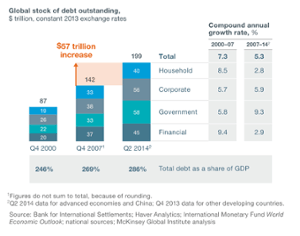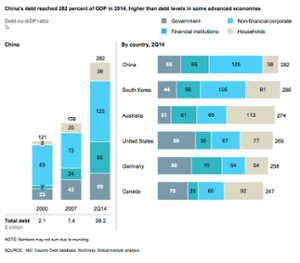Global debt has increased by $57 trillion in the seven years following the financial crisis, according to a new report, while China’s debt as a share of GDP now stands at higher than that of the US

On March 5, 2015, Ami Sedghi writes in The Guardian:
Global debt has grown by $57 trillion to reach $199 trillion in the seven years following the financial crisis – a 40.1% rise, according to a new report. All major economies are now recording higher levels of borrowing relative to gross domestic product (GDP) than they did in 2007.
Total debt as a share of GDP stood at 286% in the second quarter of 2014 compared with 269% in the fourth quarter of 2007.

The McKinsey and Global Institute study which analyses the evolution of debt in 47 countries, found that government debt is “unsustainably high” in some of those, with government debt growing by $25 trillion since 2007. The study found that in 10 of the countries studied, it exceeds 100% of GDP.
Government debt-to-GDP ratios will to continue to rise over the next five years in a number of countries including Japan, the US and most European countries (except Germany, Ireland and Greece), according to the study.

China’s total debt has nearly quadrupled over the same period, rising from $7 trillion in 2007 to $28 trillion by mid-2014. The rise, say the authors, has been fuelled by real estate and shadow banking – half of loans are linked to real estate, while nearly half of new lending is attributed to unregulated shadow banking. The country’s debt as a share of GDP stands at 282% – higher than that of the US and Germany.
The report also warns that household debt is “reaching new peaks”. Only in Ireland, Spain, the UK and the US have households deleveraged. According to the study, not only have household debt-to-income ratios continued to rise, they now actually exceed the peak levels in the crisis countries before 2008 in some cases, including advanced economies such Australia, Canada and Denmark. More flexible mortgage contracts, clearer personal-bankruptcy rules, and tighter lending standards are among its recommendations to avoid another property-related debt crises.
However, there is a spot of good news in the report: the financial sector has deleveraged, says the report, with the most damaging elements of shadow banking in the crisis in decline.

